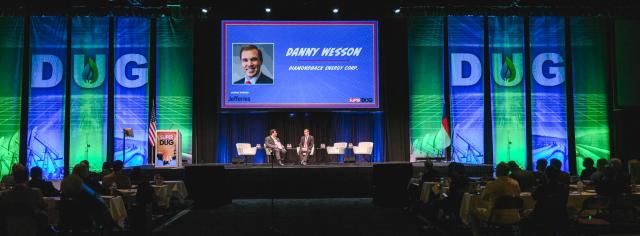
Diamondback Energy COO Danny Wesson during SUPER DUG 2023 in Fort Worth, Texas. (Source: Hart Energy staff)
FORT WORTH, Texas —Permian Basin production will likely peak around 2030, Diamondback Energy COO Danny Wesson said May 22 during Hart Energy’s Super DUG event.
Oil prices are a large part of the basin’s production reaching a peak, plateauing and then declining, Wesson said during a question and answer session with Hart Energy Senior Editor Chris Mathews.
Wesson also highlighted the M&A environment in the Permian, where public and private E&Ps are jockeying for inventory, although some companies are coming to market to test the bid-ask spread.
On production, Wesson said Permian volumes could grow if oil prices were to rise rapidly over the next year or two.
“[By] the end of the decade… plus or minus a couple of years, you might see the Permian peak and start plateauing,” Wesson said. “The longer it takes us to get there, the longer it will plateau and run flat. But the faster we get there, it will decline faster. I think end of decade is a good time to think about [flat or declining production], but you can't count the Permian out.”
Wesson said the amount of inventory and resource in place in the Permian “was phenomenal,” adding that he “wouldn't bet against the U.S. oil and gas industry when it comes to unlocking that resource.”
Asked about natural gas takeaway capacity constraints in the Permian, where associated gas can be stranded, Wesson pointed out that relieving the bottleneck should happen soon.
“There have been some upgrades and new pipes announced and should be online within the next couple of years. And until then, it's going to be very tight. We're going to get to a point in time where we're going to have really tight constraints coming out of the Permian.”
In terms of the Permian’s growth potential, Wesson said gas production could eclipse oil production, necessitating more infrastructure.
“Permian gas production is going to continue to grow and at a faster rate than oil production. And we think we will likely need another pipeline before the end of the decade. That associated gas has been really robust and created a lot of challenges,” Wesson said.
Diamondback is currently running about 16 rigs, and has four simul-frac fleets running, two of which are fully electric. In 2023, the company expects to spend about $2.5 billion to $2.6 billion, bring online between 325 wells to 330 wells and boost production slightly year-over-year, Wesson said.
Permian M&A tougher
For M&A, the basin has and remains locked in a contest of rivals, particularly in core areas. Wesson said there are fewer deals to be done with some private companies.
“There're not too many privates that are willing sellers… There are a few very large privates who are not sellers, and then the public for public M&A was always difficult. You're certainly seeing privates come to market, this is the time of the M&A cycle… [and] it’s just where’s that bid and ask spread at and when it makes sense you’ll see deals get done.”
Wesson believes public for private details will continue.
“You're seeing a lot of privates that have sold in the past 12 or 18 months starting to get refunded. And [that] drives more frothiness to the basin and opportunities. So you're going to start seeing the funding flow back into the private space, and that's exciting because the independents don’t do a whole lot of in-basin exploration, so we need those [banks or fund] out there putting dollars to work, putting packages together.”
Diamondback’s own M&A plans are more measured. Wesson said there was no pressure to do a deal.
“When the right deal comes up for the right price, we certainly will be actively engaged in that, as we always have,” he said.
Recommended Reading
TPG Adds Lebovitz as Head of Infrastructure for Climate Investing Platform
2024-02-07 - TPG Rise Climate was launched in 2021 to make investments across asset classes in climate solutions globally.
Air Products Sees $15B Hydrogen, Energy Transition Project Backlog
2024-02-07 - Pennsylvania-headquartered Air Products has eight hydrogen projects underway and is targeting an IRR of more than 10%.
NGL Growth Leads Enterprise Product Partners to Strong Fourth Quarter
2024-02-02 - Enterprise Product Partners executives are still waiting to receive final federal approval to go ahead with the company’s Sea Port Terminal Project.
Sherrill to Lead HEP’s Low Carbon Solutions Division
2024-02-06 - Richard Sherill will serve as president of Howard Energy Partners’ low carbon solutions division, while also serving on Talos Energy’s board.
Magnolia Appoints David Khani to Board
2024-02-08 - David Khani’s appointment to Magnolia Oil & Gas’ board as an independent director brings the board’s size to eight members.






